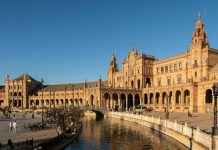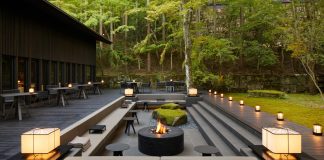Bangaan Rice Terraces: A UNESCO World Heritage Site in Banaue, Ifugao
Nestled within the highlands of Ifugao within the Philippines, the Bangaan Rice Terraces is a fascinating example of ancient agricultural ingenuity. These terraces, crafted by the Ifugao people over two thousand years ago, is breathtaking, with layers of meticulously carved paddies that appear to ascend to the heavens. The importance of this site transcends its picturesque landscapes, because it stands as a logo of the harmony between humankind and nature.

As one in all the five clusters that make up the UNESCO World Heritage Site referred to as the Rice Terraces of the Philippine Cordilleras, the Bangaan Rice Terraces are a testament to the cultural traditions of the Ifugao community which were preserved and passed down through generations. Despite modern pressures, the Ifugaos have maintained the terraces without modern machinery, relying as an alternative on ancestral methods and communal cooperation, which add to the terraces’ authenticity and cultural importance.
The Bangaan Rice Terraces is an agricultural marvel and a sustainable ecosystem supporting various indigenous wildlife. The terraces highlight the Ifugaos’ profound understanding of their environment, showcasing a living cultural landscape where farming practices, rituals, and festivals proceed to thrive. Visitors to this corner of the Philippines are offered a window into the Ifugaos’ enduring lifestyle and deep connection to the earth.
UNESCO World Heritage Status
The Banaue Rice Terraces, which include the Bangaan Rice Terraces, were inscribed on the UNESCO World Heritage list in 1995. Recognized under Criterion (iv), these terraces are a testament to the ingenious use of natural resources by the Ifugaos for community-based rice agriculture. This inclusion elevates their status not only as a national treasure but in addition as a site of worldwide importance.
Cultural and Historical Significance
As a key a part of the Ifugao province, the Bangaan Rice Terraces embody a National Cultural Treasure of the Philippines. They encapsulate centuries of Ifugao traditions, not only of their construction but in addition within the unity of community efforts and their sacred rituals related to rice cultivation. This area is greater than an agricultural site; it’s a cultural landscape that reveals the philosophical and spiritual values of the local people.
Constructed across the 1st century CE, the Bangaan Rice Terraces manifest an early innovation in wet-rice agriculture. Their historical development, as observed in various records, provides insight into the adaptive techniques of the Ifugao people in harnessing each the challenges and opportunities presented by their mountainous terrain. Over generations, these rice terraces have been meticulously hand-carved from the hills, showcasing a sustainable and enduring agricultural system.
Location and Coordinates
The Bangaan Rice Terraces are situated in the guts of the Philippine Cordilleras within the province of Ifugao, Northern Luzon. The coordinates place Bangaan roughly 350 km north of Manila, nestled in a lush, mountainous region, which speaks to each its isolation and its remarkable approach to rice cultivation.
Climate and Ecosystem
Banaue experiences a subtropical climate, with temperatures that change significantly as a consequence of the mountainous terrain. This area is characterised by a wealthy biodiversity and a fancy ecosystem that features each endemic and agricultural species. The environment here is rigorously managed to take care of the fragile balance vital for the terraces to thrive.

Irrigation Systems
One in every of the engineering marvels of Bangaan is its ancient irrigation systems. Fed by natural springs and rivers from the rainforests above, the irrigation is a masterful use of gravity, channeling water through the terraces. Not only does this sustain the environment and support rice cultivation, however it also nurtures the nature around it, promoting a dynamic, living landscape.
Attending to Bangaan
Tourists can reach the Bangaan Rice Terraces by taking a bus from Manila on to Banaue, which takes about 9 to 12 hours. Upon arrival in Banaue, visitors may hire a van or a tricycle for a more intimate journey through the scenic roads resulting in the terraces. The network of travel options ensures that while the terraces are remotely situated, they continue to be accessible for those in search of to experience this cultural landscape.
Activities and Experiences
Once in Bangaan, tourists are met with a variety of activities that immerse them in the wonder and culture of the world. They’ll partake in trekking tours that weave through the verdant rice paddies, offering unique perspectives and photo opportunities of the jar-like terraces. For a deeper cultural experience, visitors may additionally engage with the local Ifugao communities, where they’ll learn concerning the indigenous traditions and the history of the rice terraces.

Accommodations and Amenities
Though the agricultural setting might imply scarce facilities, tourists will find quite a lot of accommodations in and around Bangaan. These range from traditional Ifugao huts for an authentic stay to more conventional lodges. Local amenities also cater to tourists, providing basic but essential services that contribute to a snug and memorable visit. Whether staying inside Bangaan or within the nearby Banaue town center, travelers may have access to necessities complementing their journey through this heritage site.
Ifugao People and Traditions
The Ifugao individuals are the custodians of the Bangaan Rice Terraces, fostering a living cultural landscape. This Living Cultural Landscape is alive with rituals and festivals that mark the agricultural calendar, deeply rooting their identity in these terraces. Festivities often feature wood carvings, a conventional craft symbolizing on a regular basis life and spiritual beliefs. These carvings will not be merely decorative; they’re steeped in meaning and are integral to Ifugao culture.

Agricultural Methods
Traditional Farming techniques in Bangaan Rice Terraces have been honed for over two millennia. Ifugao farmers employ an intricate system of irrigation and utilize specific rice varieties suited to the terraced landscape. The knowledge of maintaining the terraces is crucial, because it requires precise engineering to make sure sustainable water flow and soil fertility. Pest control and the timing of planting and harvesting are orchestrated based on generations of experience, making the terraces not only an agricultural wonder but in addition a testament to the Ifugaos’ understanding of their environment.
Community Involvement
The conservation and sustainability of the Bangaan Rice Terraces are deeply intertwined with community involvement. The Ifugao individuals are the stewards of those terraces; their commitment is important for each the preservation of their cultural heritage and the success of conservation efforts. Local engagement has been catalyzed by cooperative approaches and academic programs designed to boost awareness concerning the significance of the terraces.
The involvement of the host community is reflected within the ways management decisions are made, with considerations for the local lifestyle and the environment on the forefront. Financial investments, like those aimed toward the rehabilitation program for the rice terraces, include the local populace in each planning and execution, ensuring that conservation measures are practical and helpful for all.
Nearby Rice Terraces
Batad Rice Terraces: Sometimes called the “amphitheater terraces,” these are a unprecedented example of the indigenous Ifugao’s engineering marvels. Positioned roughly an hour away, Batad offers visitors difficult treks with rewarding views. Hapao Rice Terraces: For those in search of a less strenuous experience, the Hapao Rice Terraces present a calmer setting. They’re inside a day’s journey from Bangaan and supply a serene backdrop for leisurely walks.
Cultural Landmarks
Banaue Museum: A brief drive from Bangaan, the Banaue Museum houses artifacts and exhibits that tell the story of Ifugao culture. It showcases traditional clothing, weapons, and tools that supply insight into the history of the region’s indigenous people.
Natural Wonders
Tappiya Falls: Positioned near Batad, Tappiya Falls is a natural wonder where visitors can enjoy a refreshing swim after a hike through the rice terraces. The waterfall is enclosed by lush greenery, making a serene atmosphere for rest and reflection.

Often Asked Questions
The Bangaan Rice Terraces are a big cultural site with interesting access details, entry regulations, and a singular historical background. These often asked questions provide concise information on what visitors should know.
How can one access the Bangaan Rice Terraces?
Visitors can access the Bangaan Rice Terraces through the Ifugao province. The journey often features a drive to Banaue and a trek or ride to the positioning.
What are the entry fees for visiting the Bangaan Rice Terraces?
There is no such thing as a environmental fee required for entry to the Bangaan Rice Terraces.
Are you able to provide a temporary description of the Bangaan Rice Terraces?
The Bangaan Rice Terraces are a cluster of ancient, man-made terraces carved into the Ifugao mountains, showcasing a picturesque landscape of cultivated land.
What’s the historical significance of the Bangaan Rice Terraces?
They stand as a testament to the Ifugao’s ingenuity and the sustainable agricultural practices they’ve maintained for over two millennia.
How are the Bangaan Rice Terraces related to the opposite rice terraces within the Philippines?
The Bangaan Rice Terraces are a part of the Rice Terraces of the Philippine Cordilleras, a UNESCO World Heritage Site that features Batad, Mayoyao, Hungduan, and Nagacadan.
What distinguishes the Batad Rice Terraces from the Bangaan Rice Terraces?
While the Batad Rice Terraces are renowned for his or her amphitheater-like shape, the Bangaan Rice Terraces offer a more expansive view of a jar-like formation and are more accessible to visitors.
Ifugao Travel and Tour Packages
Want more updates about recent package tours and tourist attractions in Ifugao, Philippines, you can include in your itinerary?
Follow #TeamOutofTown, on Facebook, Twitter, Instagram, Bloglovin, and Pinterest for more travel ideas.
Read:
Unlock the world’s wonders with unforgettable journeys tailored just for you! Whether you crave sun-kissed beaches, thrilling adventures, or rich cultural escapes, your dream destination awaits. Enjoy seamless travel with expert tips, exclusive deals, and handpicked experiences that Turn Every Trip into a lifetime memory.










